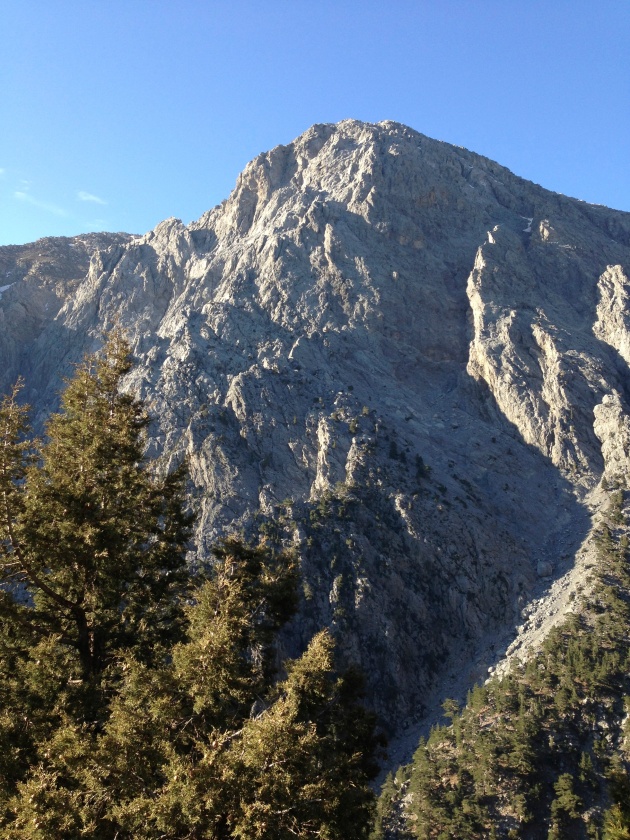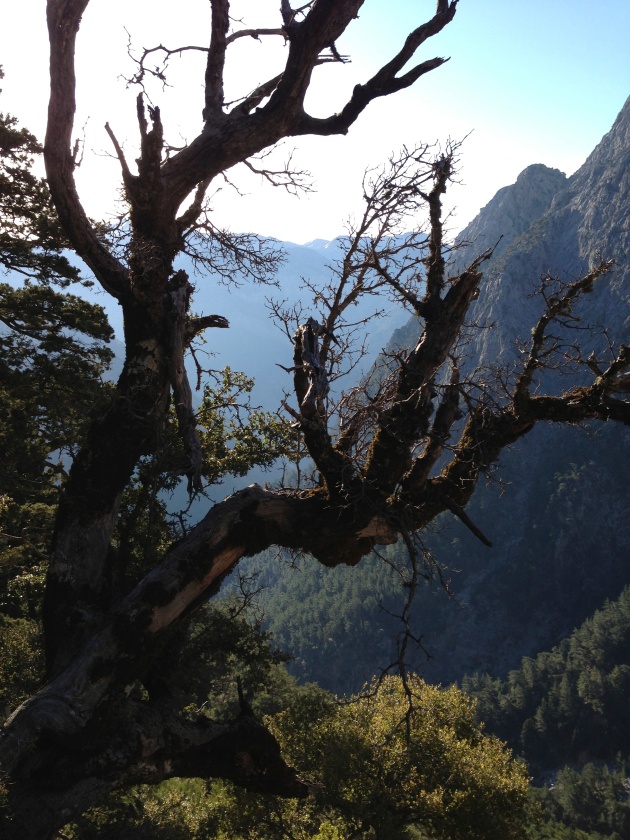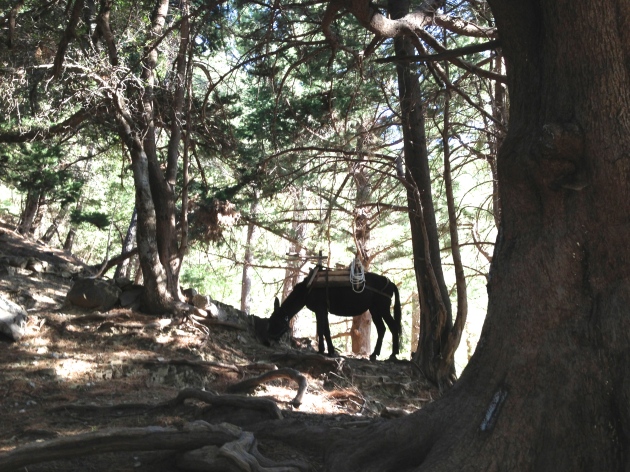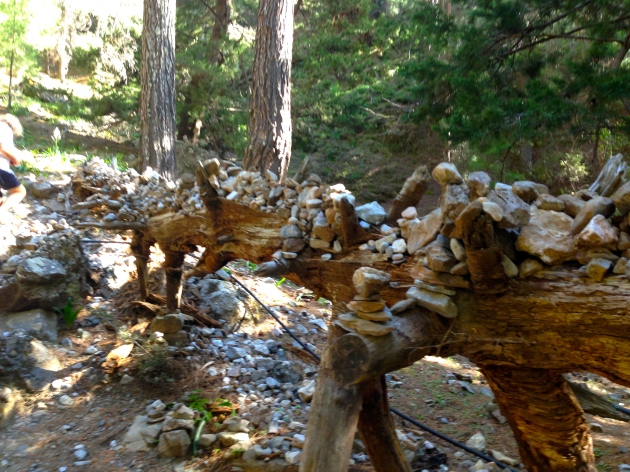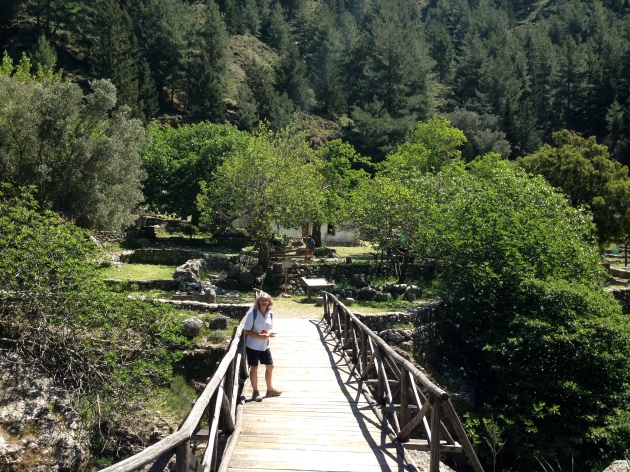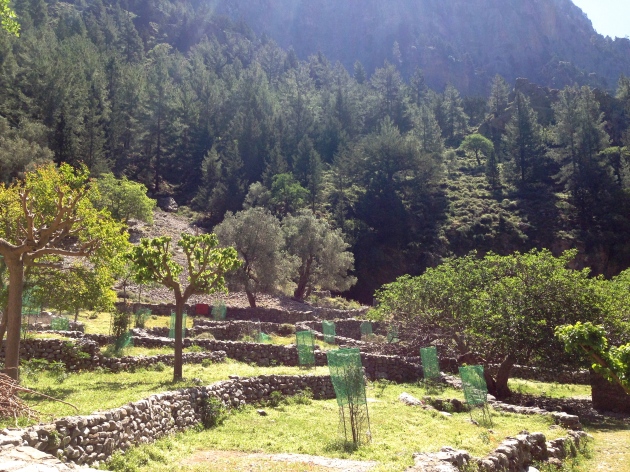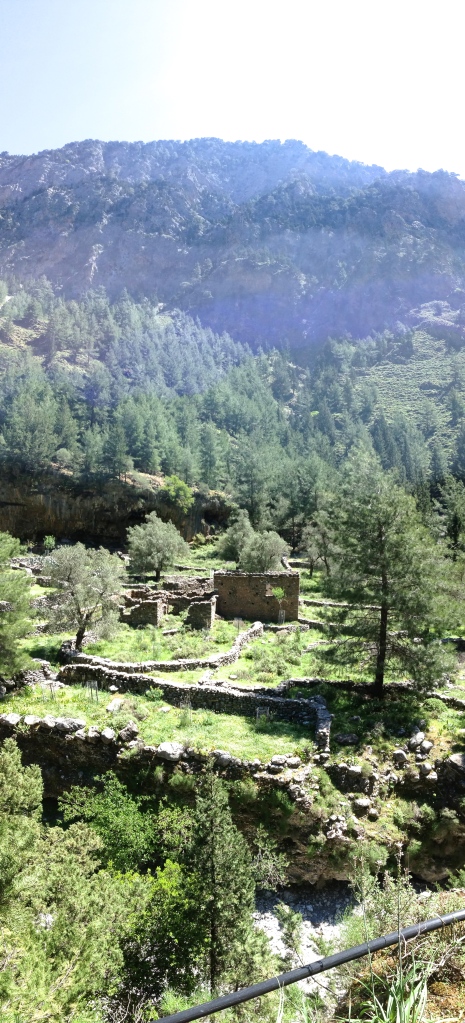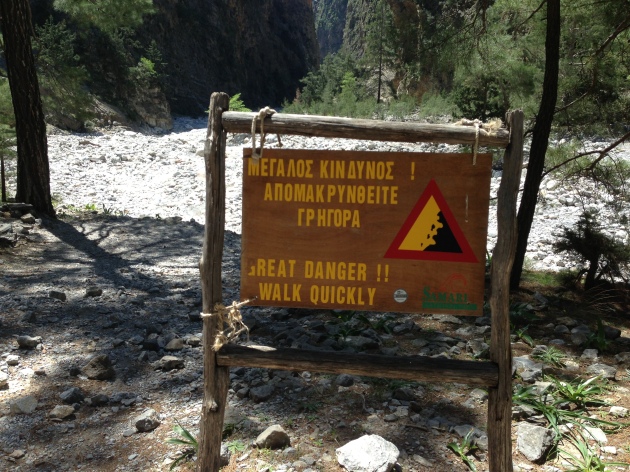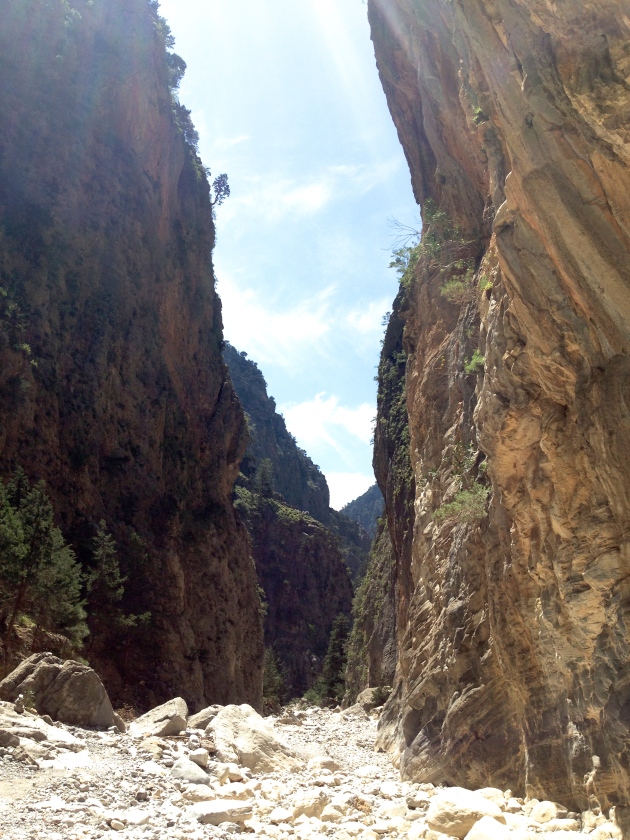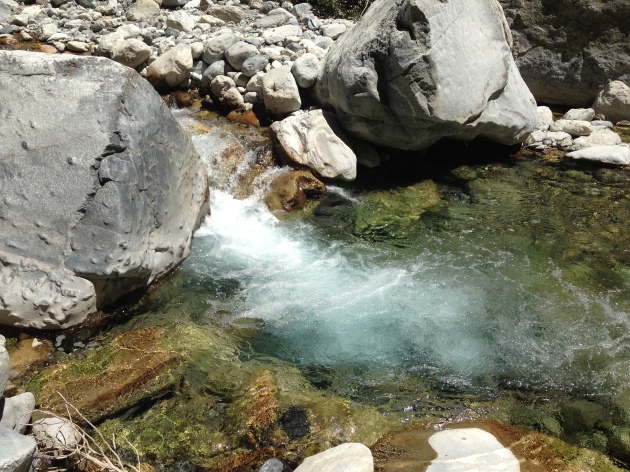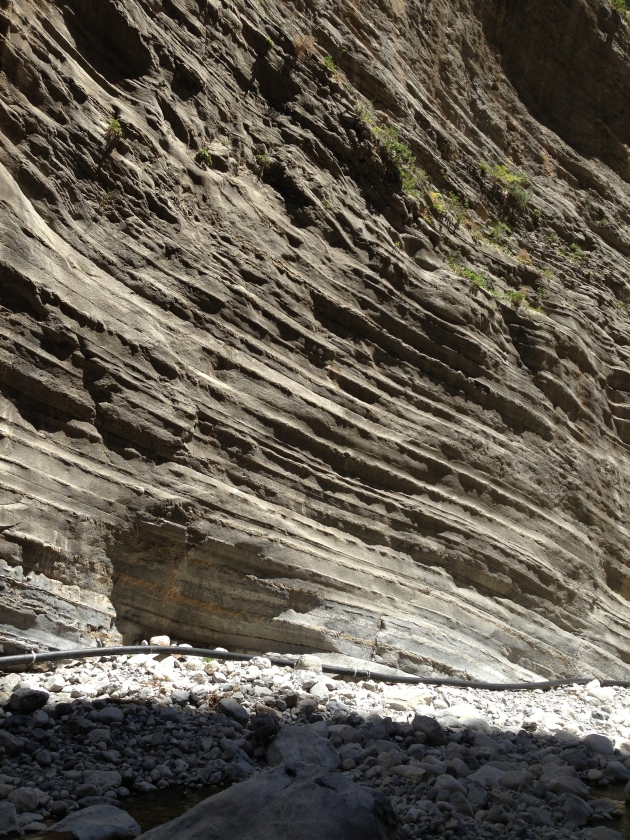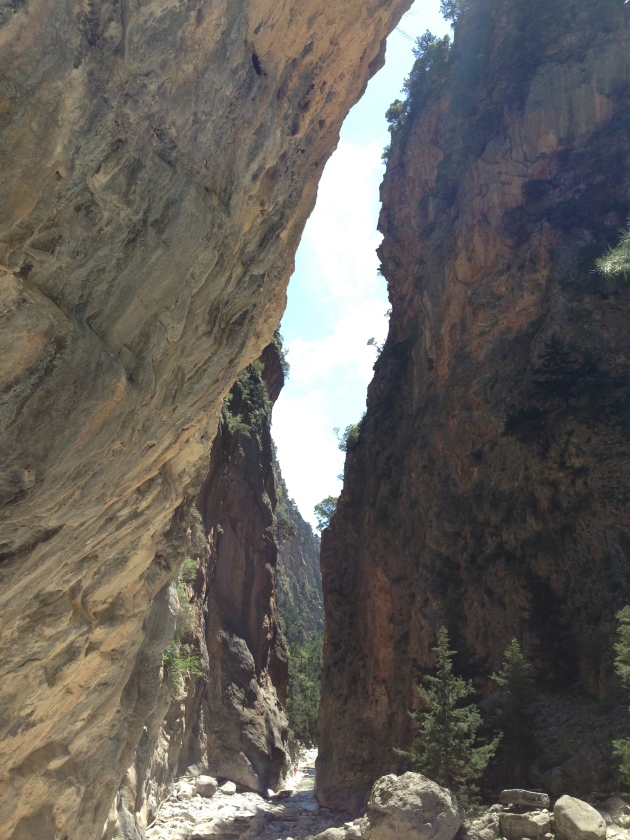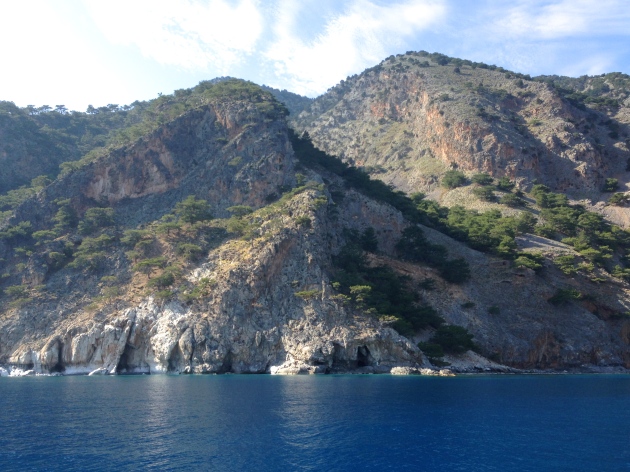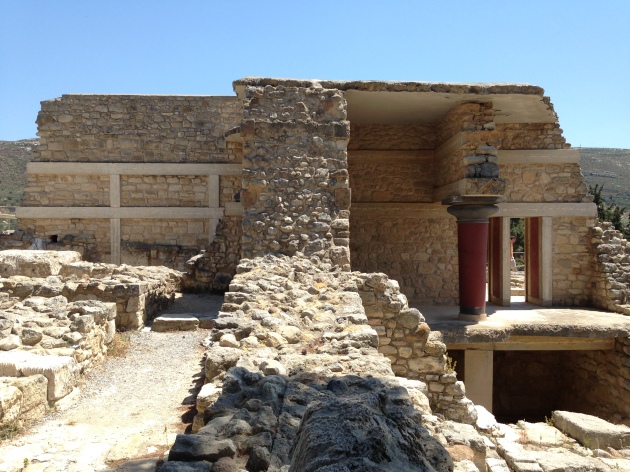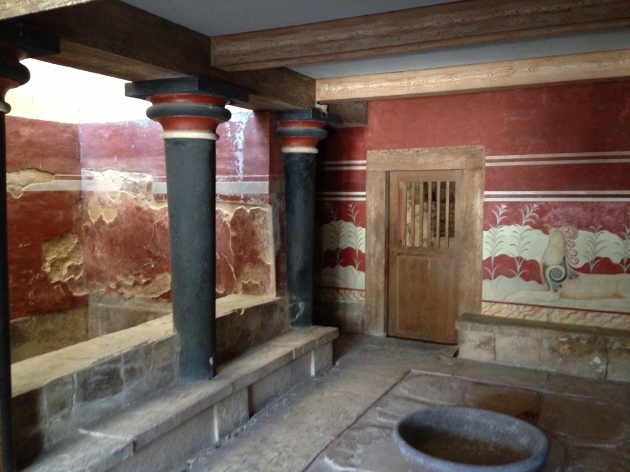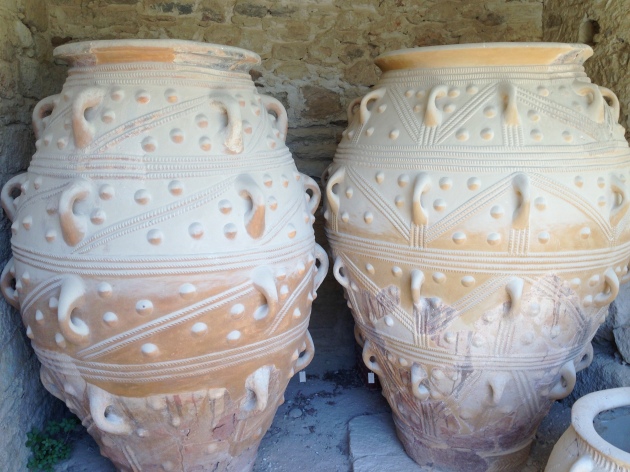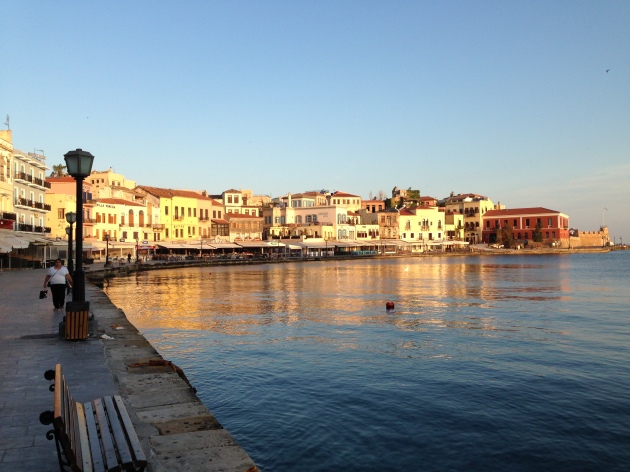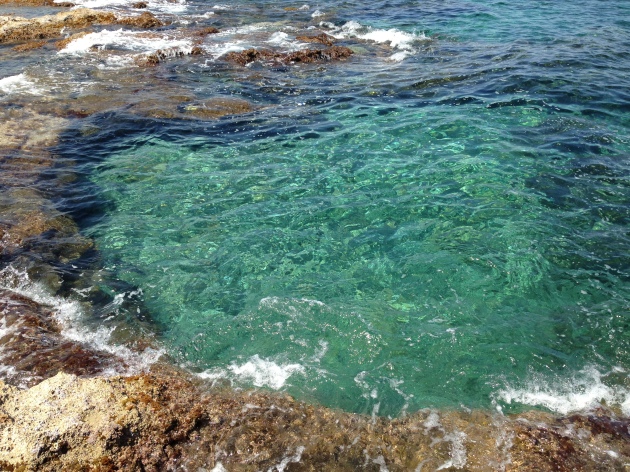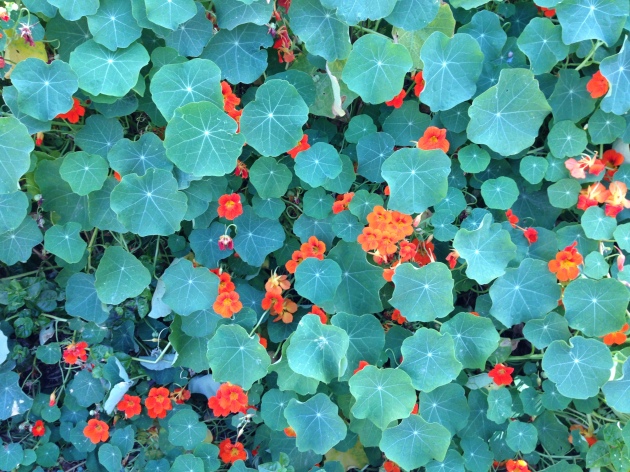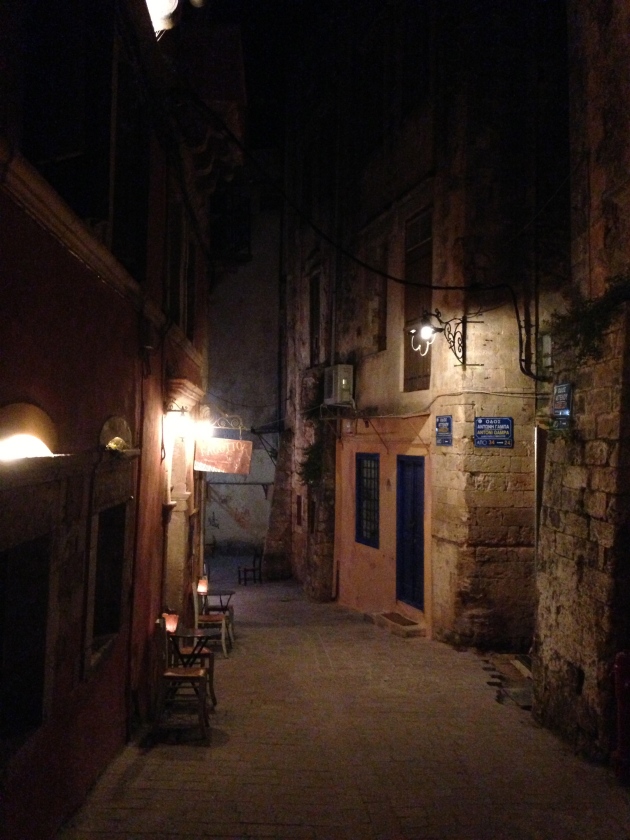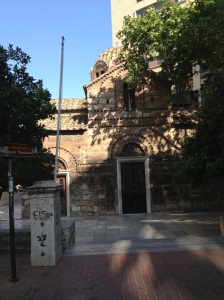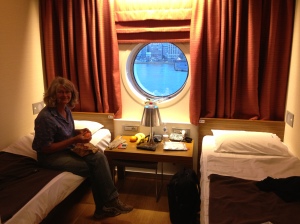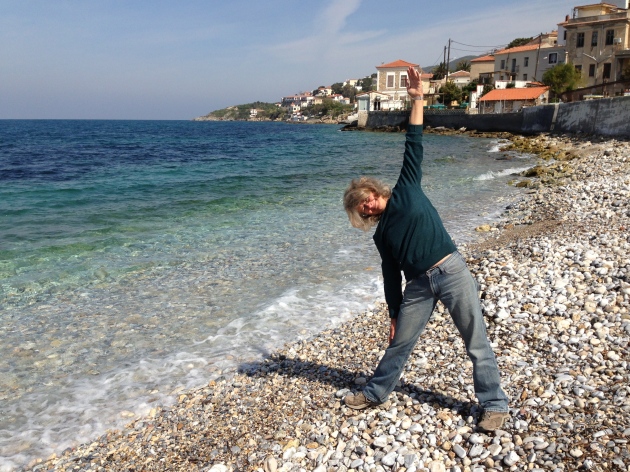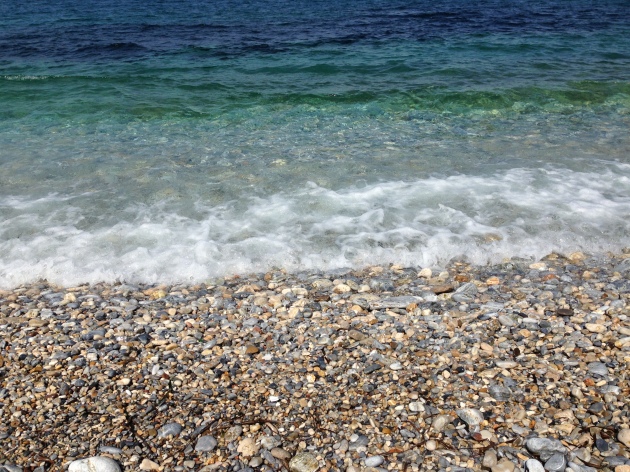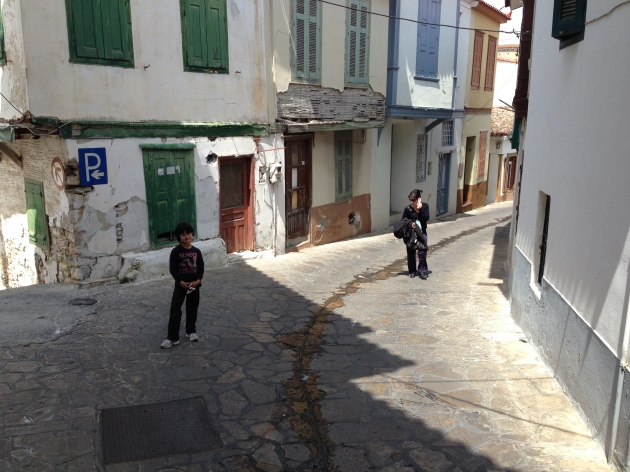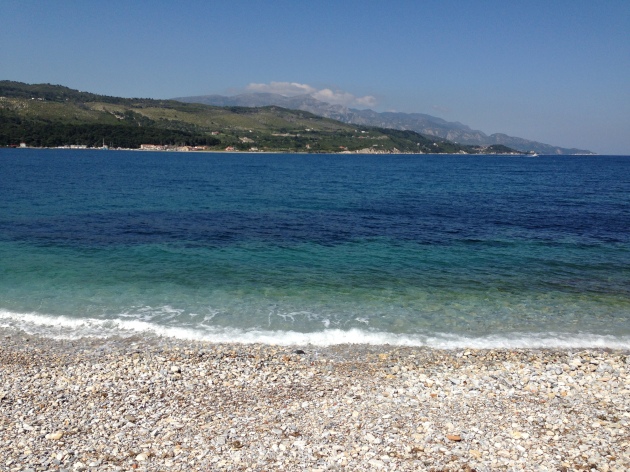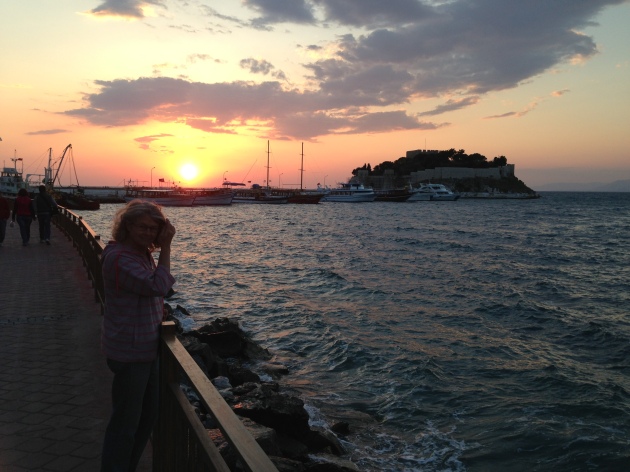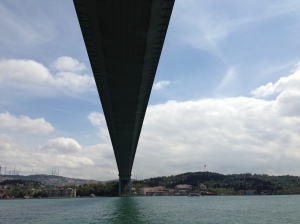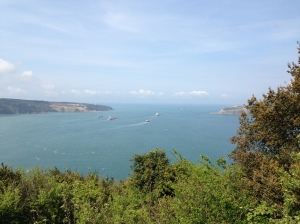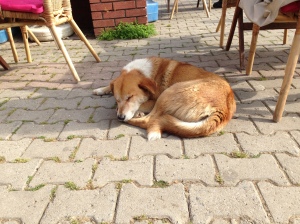Today we are off to the Samaria Gorge, with high anticipation. We set 5 am alarms (!) to be ready for the bus at 6.15 am. As we do the 10-minute walk through the dawn to the bus pickup point outside the Tellus travel agency, the town is still humming with nightlife: the clubs and bars are full (as are many of the patrons) and young men are revving the engines of cars and bikes. Phoooaaarrr.
We’re on the bus and under way by 6.30 am, part of a group of about 20. Our guide (Marco, a handsome young Cretan with a nice turn of phrase) explains the way it will work: the bus takes us to the entrance to the Samaria National Park at the top of the gorge, from where we all walk through the gorge (16 km, and a descent of around 1200 m) to the small town of Agios Roumeli on the south coast of Crete. We walk at our own pace (with Marco last in case of problems) and meet at the Kri Kri hotel to catch a 4.30 pm ferry to Sougia, about 15 km to the west, where the bus meets us for the return trip to Chania. The ferry journey is needed because Agios Roumeli is accessible only by water. Marco also tells us that we’re the first walking party for the spring, and later in the year the gorge will be crowded. Hence, we are doubly lucky in our timing: to be able to do the walk at all, and also to do it at an uncrowded time.
We arrive at the top of Samaria Gorge around 8 am, after a short stop along the way for coffee and pastries. The bus has to negotiate a winding mountain road with hair-raising hairpin bends, and with a lot of road-building equipment here and there because the road is being upgraded to cope with the volume of tourist traffic to the gorge.
As we alight at the top of the gorge, the view is utterly breathtaking. We’re at 1200 m, with surrounding mountains rising to over 2000 m; this is the main range that forms the east-west spine of Crete. The mountain immediately in front of us is Gigilos, the summer residence of Zeus. We’re in a forest of pine (two main species including Cypress pine, which is native here). The treeline is a few hundred metres above us, and above that, the mountains are jagged grey rock with many rockfalls and sheer cliffs. It’s impossible to catch the grandeur of this place in pixels, but that doesn’t stop us making many attempts with iPhones.
Mt Gigilos (summer holiday house of Zeus, the alpha god) at the start of the Samaria Gorge walk
Looking east at the start of the walk: through a cypress pine that’s just hanging on
We start the walk down through the gorge at about 8.15 am. The air is cool, clear and crisp and the sky is bright blue and cloudless, like a clear Australian sky and quite unlike the hazy skies of northern Europe. The light is dappled. The path descends steeply but is wide, very well maintained, and quite easy walking.
There are about 10 stopping points along the walk (including start and finish). We come to the first of these after about a half hour, including many pauses for photos – a high proportion these don’t turn out because of the great sun-shade contrasts, and the breadth and height of the scenery, filling half the sky. Early on, we pass a saddled mountain pony grazing by the path; ponies are the local ambulances, ferrying out the walkers who sprain ankles or break bones. There must be plenty of work for the ponies through the summer, but I don’t want to be one of their customers!
Tha Ambulance Pony takes a break
A little further we come to a couple of stones sitting on top of one another – then a couple more, then more, and soon a fallen pine tree with stones balanced along the entire length of its trunk. It’s a self-organising Andy Goldsworthy sculpture! Later we ask Marco the reason: he says that mountain climbers used to mark the path for those following with balanced stones, and that the custom spread among tourists.
An Andy Goldsworthy without the intervention of Andy Goldsworthy
There are more of these self-organising sculptures. Across the space under a huge rock by the path, sticks have been leant to form a little leaning-stick wall, and smaller ones lain down to form row of parallel sticks.
By about 9.45 am we reach Agios Nikalaos, a tiny and very pretty church by the side of the path. This is a reminder that the gorge has been inhabited for thousands of years. Although no-one lives here any more, the inside of the church is clean and lined with Greek Orthodox icons – the church is obviously maintained. Marco tells us that the sites of these mountain churches had all been earlier shrines to Greek gods, and Christianity displaced the older religions partly by putting its imprints firmly on the older sites.
At all of the stopping points there are natural springs flowing into stone bowls, providing continuous drinking water as part of the (presumably ancient) infrastructure for this trail. Clearly this water is well regarded in Crete; I had earlier bought a bottle of drinking water called “Samaria Water”, which I’m now carrying back to its alleged source!
The day is now warming up, though still pleasantly cool, and the path is winding to and fro across a small river, with stepping-stone crossings. The vegetation is still dominated by pine but deciduous trees – mainly oak – are starting to appear. There are herbs in the ground cover, and we see a few “dragon plants” or “dragon flowers” – a small, spiky, evil-looking plant with a single large crimson flower that emits a smell of rotting meat to attract the flies that pollinate it.
Around 11.45 am we reach Samaria, the tiny village sharing a name with the gorge. It’s no longer inhabited, but is used as a guard post by the park rangers (whom seem to be Greek military personnel). There are quite a few stone cottages, terraced gardens for vegetables, and many old fig, olive and fruit trees. The grass is green and low, probably kept that way by goats (though we don’t see any). The local wild goats are kri-kri, the Cretan goat, a large brown horned goat that’s an endangered species and very sensibly heads for the high mountains as soon as the first walking groups arrive in spring (that’s us).
Springs run into stone bowls. The river divides the town in two, with the path on the west and most of the buildings on the eastern side. A wooden bridge crosses the river, which here is dry; the earlier flow, further up the mountain, has vanished underground. The mountains tower above the place, and the atmosphere is cool, moist and green.
Crossing the bridge into Samaria Village
An orchard at Samaria Village, still well maintained
The last inhabitants had to leave when the Samaria Gorge area was declared a national park in 1962. I wonder how they felt about leaving? The place is difficult to access – the only way in and out being the path we’re following, and everything would have had to be carried in and out by people and packhorses. However, it’s a place of indescribable beauty and tranquillity – the Rivendell of its valley – and indeed, this valley could have been the original inspiration for Lord of the Rings.
This place, far more than Knossos yesterday, lets me imagine what life must have been like for its inhabitants. Even a few decades ago, this village would have been home for a number of families. It would have produced much of its own food, with goats for milk and meat, vegetables, fruits, figs and olives. Travellers perhaps used the gorge for centuries as a path across the mountains, taking the same route that we’re following. Samaria village would have been an important stopping place, providing hospitality and receiving much of its news and exchange with the outside world in that way. Perhaps young people left the village in search of wider horizons, leaving a progressively dwindling older population. Perhaps the last inhabitants departed their beautiful and remote valley in 1962 with mixed feelings, not all of them of loss.
A panorama from sky to river as we leave Samaria Village
We leave Samaria Village – about the half-way point in distance – after midday. The path is now less steep, though still quite rugged, and here and there it has been roughly paved – presumably remnants of an old paved path between the village and the coast. We cross the river – now flowing again – many times, using simple wooden bridges rather than stepping stones.
Helpful advice before entering Samaria Gorge
Soon we enter Samaria Gorge itself. The mountain walls tower above for many hundreds of metres, often in sheer cliffs. Here and there, trees cling to crevices in the rock. We try many times to photograph this grandeur, but it’s too big to fit onto an iPhone image. Eventually, after narrowing progressively over a few kilometres, the gorge walls are only a few metres apart for a section of about 100 metres. This forms “the Gates”, the most iconic part of the gorge – though far from the only part of stunning majesty.
A little way into Samaria Gorge
The river is flowing again
Wonderful striations in the western wall
Entering The Gates
After the Gates, the gorge tapers towards the sea. The southern park entrance is about 3 km from the coast, leaving this stretch as a pleasant walk along a dirt road with a few houses, a small church, and one tiny hermit-like door in the cliff high above the church. There are goats in pens and tended vegetable gardens.
Finally, around 3 pm, a bit footsore but high on the wonder of the place, we reach Agios Roumeli for the ferry home. We celebrate with delicious (though outrageously expensive!) fresh orange juices and bowls of Cretan yogurt and honey – this yogurt is much thicker and creamier than what we’re used to.
The ferry to the nearest road, at Sougia to the west, takes about a hour. The coast is spectacularly arid and mountainous, with many caves and small gorges. We are sailing on a very calm Libyan Sea, with Africa only 250 km to the south.
The southern coast of Crete between Agios Roumeli and Sougia
We board the bus at Sougia for an evening ride back to Chania, taking a bit over 1.5 hours to cover a direct line of only 50 km. The road crosses the mountains with multiple twists, turns and hairpins. The mountain countryside is cultivated surprisingly intensively, with olive orchards everywhere and small villages every few kilometres along the road.
Back in Chania by 7.45 pm, we start to feel as if we’ve done some walking. We have a quick dinner at a restaurant very near our apartment. It’s been a fabulous day, one of the highlights of the trip so far.
